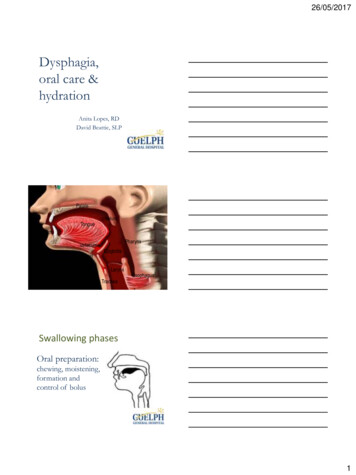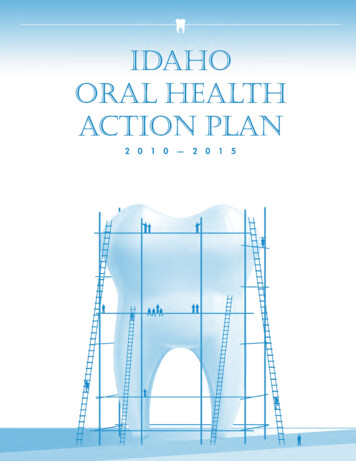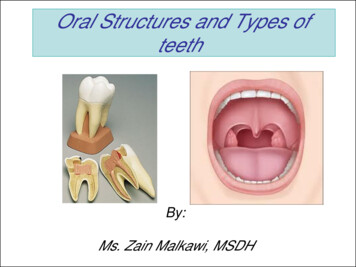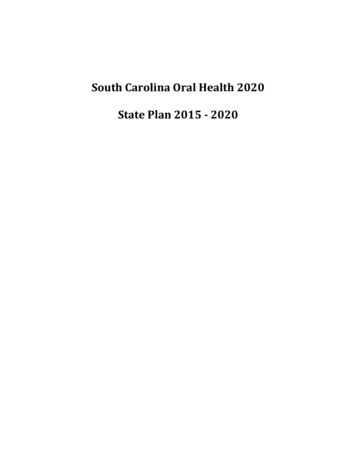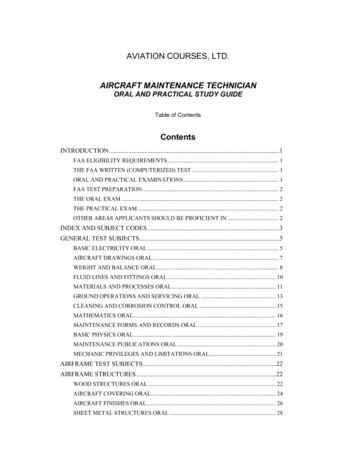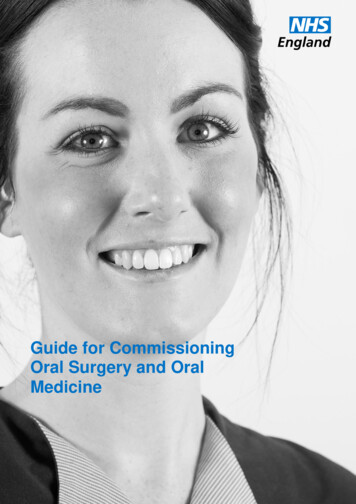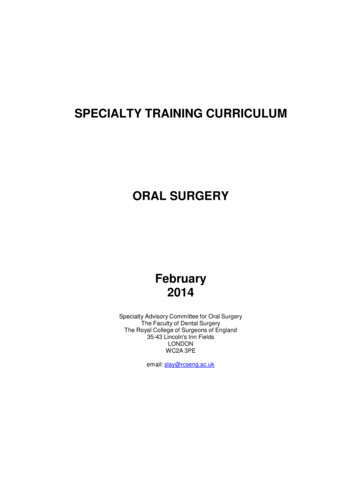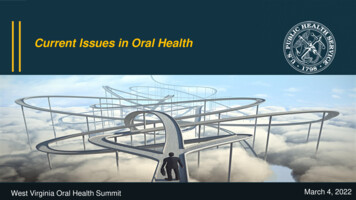
Transcription
Current Issues in Oral HealthWest Virginia Oral Health SummitMarch 4, 2022
Overview1.About the U.S. Public Health Service2.The Pandemic & Oral Health3.Oral Health in America, Advances and Challenges 4.Oral Health, the Community, and the EconomyChildren & AdolescentsWorking-Age Adults and Older AdultsWorkforce, Education, and IntegrationMental Illness and Substance UseEmerging Science & TechnologyHealthy People 2030Overview2
Overview of the USPHSAbout the USPHS3
“Protect, Promote, and Advance the Health & Safety of the Nation”About the USPHS4
USPHS Dentist LocationsAbout the USPHS5
COVID-19 Public-Private Partner Dental Coordination GroupFederal Entities:BOPCDCCMSDoD (A, AF, N)FDAHRSAICE HSCIHSNIDCROSHAUSPHSVHA14Major PHDACPASDA99MedicalOrganizations:Other National Dental & PublicHealth DAAWDCareQuestACDComm. CatalystACFFDTAADEAForsyth Inst.ADSOMSDAAFSNADLNADPNMCHOHRCNNOHAOPENOSAPProj. AOHSanta FeAAPAPHANIIOHNRHA284Partnerships6
Oral Health Interconnectivity“5-eyes” Colleagues: Canada New Zealand Australia U.K. (England, Ireland,Scotland, Wales)USPHS Categories: DieticiansEngineersEnvironmental HealthHealth Services pistsVeterinariansPartnerships7
The PandemicPandemic8
Pandemic Update: Children’s Medicaid Dental ServicesMedicaid children’s dental services are still below pre-PHE levels. loads/covid19-data-snapshot-11122021.pdfPandemic9
Impact on JfM3BaeGhzWm12TnNMdjB4Pandemic10
Dental Scopes of Practice Expansion – COVID-197th PREP Act amendment, effective 3/11/2021, supersedes state authorization.DentistsHygienists# of states allowing dentalstaff to administer COVID-19vaccine2418# of states allowing dentalstaff to administer influenzavaccine81# of states allowing dentalstaff to administer /covid-19-resourcesGEORGIA: 1/15/21 – Gov. Kemp gave temporary authorization todentists.Pandemic11
Vaccinator JfM3BaeGhzWm12TnNMdjB4Pandemic12
Reasons for Not tVVJfM3BaeGhzWm12TnNMdjB4Pandemic13
Staffing Shortages35.8% of dentists recruiting dental assistants28.8% seeking dental hygienists26.5% seeking administrative staff13.1% seeking -emerge-from-covid-19-pandemicPandemic14
Oral Health in America: Advances & Challenges15
To Access the caOral Health in America: Advances & Challenges16
Foundation: 2018 Listening SessionLeft: Steering Committee for the Report, December 2018, with former SG Jerome AdamsRight: With the NIDCR editorial team for Oral Health in America: Advances & ChallengesOHA: Background17
Report Sections Section 1:Effect of Oral Health on the Community, Overall Well-Being, andthe Economy Section 2A:Oral Health Across the Lifespan: Children Section 2B:Oral Health Across the Lifespan: Adolescents Section 3A:Oral Health Across the Lifespan: Working-Age AdultsOHA: Background18
Report Sections Section 3B:Oral Health Across the Lifespan: Older Adults Section 4:Oral Health Workforce, Education, Practice and Integration Section 5:Pain, Mental Illness, Substance Use, and Oral Health Section 6:Emerging Science and Promising Technologies toTransform Oral HealthOHA: Background19
Section 1 Overview: Effect of Oral Health on the Community,Overall Well-Being, and the Economy Good oral health supports overall health and well-being of individuals, families,communities, and the nation. Poor oral health reduces the economic productivity of society by limitingparticipation in the workforce, as well as by increasing health care costs. Natural disasters, the emergence of novel pathogens, such as COVID-19, andother large-scale emergencies underscore the need for public-private partnershipsthat plan and ensure the continued delivery of essential oral health care in times ofcrisis.Oral Health, the Community, and the Economy20
Section 1 Key Graph:Effect of Oral Health on theCommunity, Overall Well-Being, and the Economy Page 1-3 (61)Oral Health, the Community, and the Economy21
Factors Affecting Access to Dental Care – Another ModelOral DiseasesOral Health, the Community, and the Economy22
Access to Dental Care, last 20 yearsYearAccess 43.3%HP2020Goal49.0%HP2030Goal45.0%Oral Health, the Community, and the Economy23
Access by Race/Ethnicityhttps://www.ada.org/ raphic 0421 4.pdf?la enOral Health, the Community, and the Economy24
Oral Health ?utm source adaorg&utm medium hpifeaturedbox&utm content infographicsOral Health, the Community, and the Economy25
Section 1 Call to Action: Effect of Oral Health on theCommunity, Overall Well-Being, and the Economy Policy changes are needed to reduce inequities in oralhealth status and care, ensuring that all Americans canenjoy the benefits of good oral health.Oral Health, the Community, and the Economy26
Section 2 Overview: Oral Health Across the Lifespan –Children & Adolescents About half of all American children do not receive regular dental care because of social,economic, and geographic obstacles. Nearly 1 in 5 children have special physical or health care needs; providers trained inactive prevention and management of these children’s oral health problems help to supporttheir overall health and quality of life. About half of all adolescents will experience dental caries; there has been littleimprovement in the past 20 years. Risk-taking behaviors that commonly occur in adolescence, such as tobacco andsubstance use, as well as the first occurrence of some mental health problems, can affectadolescents’ long-term oral health.Children & Adolescents27
Section 2 Key Graph: Oral Health Across the Lifespan –Children & Adolescents Page 2A-7 (165)Children & Adolescents28
Section 2 Key Graph: Oral Health Across the Lifespan –Children & Adolescents Page 2B-3 (261)Children & Adolescents29
Section 2 Call to Action: Oral Health Across the Lifespan –Children & Adolescents Public policies and improved training are needed toreduce oral health inequities by encouraging healthproviders to focus more on individual and publichealth approaches to preventing the occurrence ofnew disease and managing disease earlier. Adolescence is a life stage that has been largelyneglected by researchers and practitioners in es should be developed to address theunique oral health challenges of this group.Children & Adolescents30
Section 3 Overview: Oral Health Across the Lifespan –Working-Age Adults and Older Adults Although adults now retain most of their natural teeth, many working-age adults continue toexperience the same levels of tooth decay, gum disease, and oral cancers that were observed 20years ago. Many working-age adults—especially low income and minority adults—don’t have dental insurance. Older adults are living longer than ever before, many with chronic diseases and complex healthconditions that would be best managed by medical and oral health professionals working together. As working-age adults transition into retirement, most lose their employer-provided dental insurance,and Medicare does not provide an oral health benefit. This puts their oral health at risk.Working Age Adults & Older Adults31
Section 3 Key Graph: Oral Health Across the Lifespan –Working-Age Adults and Older Adults Page 3B-7 (417)Working Age Adults & Older Adults32
Adult Medicaid Benefits 74 million Americans lack dentalcoverage. As of 2021, 21 states haveextensive dental benefits as partof Medicaid. “Extensive” or “Comprehensive”means more than 100 -resources/adult-dental-benefit/Working Age Adults & Older Adults33
Older Adult DisparitiesChanges in functional dentition ( 21 teeth) among adults aged 65and older in the United 01988-19942009-2014Dye et al. https://pubmed.ncbi.nlm.nih.gov/17633507/Working Age Adults & Older Adults34
Section 3 Call to Action: Oral Health Across the Lifespan –Working-Age Adults and Older Adults Policies are needed to improve regular access toprofessional dental care for working-age adults, assuringaccess to both preventive and early treatment services,leading to better oral health. A policy that mandates dental coverage in Medicarewould reduce health inequities for older adults byassuring access to preventive and other oral healthservices for all, including those who are place-bound orin need of caregiver assistance.Working Age Adults & Older Adults35
Section 4 Overview:Practice & IntegrationOral Health Workforce, Education, Today’s oral health workforce includes not only dentists, but other oral healthprofessionals, such as dental therapists, public health dental hygienists, andcommunity dental health coordinators and medical colleagues who provide oralhealth assessment and prevention. Although there are more oral health providers in the U.S. than in 2000, today about60 million Americans live in areas (mostly rural) where there are too few oral healthprofessionals to meet local needs. Strategies for the integration of oral and general health care delivery are emerging.Improving adults’ access to dental care will require a multipronged approach andcoordinated efforts among policymakers, insurers, and dental professionals.Workforce, Education, & Integration36
Workforce Issues – where are dentists going?Supply of Dentists, 2001-2018200,000199,486Dentists per 100,000 population, 201320142015201620172018160,000American Dental Association, Health Policy Institute. Supply of Dentists in the U.S.: 2001-2018, February 2019.Workforce, Education, & Integration37
Section 4 Key Graph:Practice & IntegrationOral Health Workforce, Education, Page 4-12 (506)Workforce, Education, & Integration38
Dental Health Professional Shortage Areas (HPSAs) Over 60 million people living indental HPSAs 6,559 dental health professionalshortage areas (HPSAs) 10,853 practitioners needed toremove HPSA kforce/shortage-areasWorkforce, Education, & Integration39
Number of Dentists Per CapitaActive Dentists in the U.S., s per Workforce, Education, & Integration40
Changing Workforce Models – Group PracticeDentist Practice Type, .30%American Dental Association, Health Policy Institute. Supply of Dentists in the U.S.: 2001-2018, February 2019.Workforce, Education, & Integration41
Changing Workforce Models - Therapy Begun in 2000 No universal model 13 states haveauthorized therapy 2004 – AlaskaAccess 2009 – Minnesota 2018 – Michigan (8th state) 9 states “actively exploringauthorizing dental se-of-dental-therapyWorkforce, Education, & Integration42
Changing Workforce Models – Dental licy-brief-workforce-utilization/Workforce, Education, & Integration43
Changing Workforce Models – Expanded Function Dental licy-brief-workforce-utilization/Workforce, Education, & Integration44
Changing Workforce Models – Community Dental Health CoordinatorsSTATUSFULL FUNCTION CDHC ON-SITECDHC HELP NAVIGATE TO PROVIDERSAccessPILOTING A CDHC PROGRAMVISITING CDHCCDHC PROGRAMS IN mapWorkforce, Education, & Integration45
Workforce i/hpigraphic 0421 1.pdf?rev aa1f41177af94613a74a307adc11f2f0&hash 8F66BABF02828DB2E9A6D5D53908F2DDWorkforce, Education, & Integration46
7.0 million 6-171.1 million 6Workforce, Education, & Integration47
Opportunities for the Present & FutureOther point of care lab testingChildhood immunizations administrationChildhood immunizations screeningHIV screeningDepression screeningSubstance use disorder screeningTobacco use screenings & counselingHPV vaccine administrationCognitive disorder screeningBMI/obesity screeningDiabetes screeningObstructive sleep apnea screeningHPV vaccine educationHypertension screeningWorkforce, Education, & Integration48
Section 4 Call to Action: Oral Health Workforce, Education,Practice & Integration Improving access to oral health care can beachieved by recognizing dental care as anessential health benefit for all Americans,expanding dental coverage for the uninsured,encouraging new professional models, and byproviding educational opportunities thatencourage interprofessional learning and thedelivery of care in new settings.Workforce, Education, & Integration49
Section 5 Overview:and Oral HealthPain, Mental Illness, Substance Use, Substance misuse and mental illness can have negative effects on oral healthand well-being. Most opioid prescriptions for dental conditions are provided in emergencydepartments—an expensive and often ineffective practice. Early research on e-cigarette use shows that it has many of the same negativeeffects on gums and soft tissue seen with tobacco use, including increasedrisks for oral malignancies.Mental Illness & Substance Use50
Section 5 Key Graph: Pain, Mental Illness, Substance Use,and Oral Health Page 5-11 (603)Mental Illness & Substance Use51
Section 5 Call to Action: Pain, Mental Illness, Substance Use,and Oral Health In order to participate fully in an integratedsystem of health care, oral health professionalsmust acquire new competencies related to thebehavioral health aspects of substance use andmental illness to provide optimal oral healthcare for, and appropriately refer, those withsubstance use disorders and mental healthproblems.Dr. Daniel Brody, a dentist at Valley Health CHC in Fort Gay, WestVirginia, screens a patient for SUD.Mental Illness & Substance Use52
Section 6 Overview:Emerging Science and PromisingTechnologies to Transform Oral Health Science and technology provide the essential foundation for preventing and treatingoral disease, and research breakthroughs during the past 20 years offer excitingopportunities to improve oral health. Discoveries related to the microbiome, genomics, and other omics offer promise forindividualizing oral health care and revealing relationships among systemicdiseases, suggesting possibilities for new treatments. The emergence of novel pathogens, such as COVID-19 and other as yet unknownagents, underscores the need to strengthen the scientific base and ensure theflexibility of the scientific enterprise to swiftly incorporate advances and technologynecessary for addressing new health challenges.Emerging Science & Technology53
Section 6 Key Graph: Emerging Science and PromisingTechnologies to Transform Oral Health Page 6-29 (703)Emerging Science & Technology54
Section 6 Call to Action: Emerging Science and PromisingTechnologies to Transform Oral Health Training, support, and mentorship of more oral healthscientists and academics are needed to ensure arobust workforce who can extend and effectively usethe advances in science that are so critical fordelivering care in the changing landscape of oralhealth.Emerging Science & Technology55
Healthy People 2030:Oral Health ObjectivesHealthy People 2030 Oral Health Objectives56
Federal Initiatives: Healthy People 2030 (healthypeople.gov)Webinar DateHealthy People Oral Health ObjectiveAlignment with national initiative/observanceMay 2022OH-4: Reduce the proportion of older adults with untreated root surface decayOlder Americans MonthJul 2022None, but preceding National Back to School MonthOct 2022OH-2: Reduce the proportion of children and adolescents with active and currently untreated tooth decayin their primary or permanent teethOH-3: Reduce the proportion of adults with active or currently untreated tooth decayNov 2022OH-6: Reduce the proportion of adults aged 45 years and over with moderate and severe periodontitisAmerican Diabetes MonthJan 2023OH-11: Increase the proportion of persons served by community systems with optimally fluoridatedwater systemsOH-1: Reduce the proportion of children and adolescents with lifetime tooth decay experience in theirprimary or permanent teethOH-7: Increase the proportion of oral and pharyngeal cancers detected at the earliest stageAnniversary of Grand Rapids, MI FluoridationJun 2023OH-D01: Increase the number of states and the District of Columbia that have an oral and craniofacialhealth surveillance systemOral Health MonthAug 2023National Back to School MonthOct 2023OH-10: Increase the proportion of children and adolescents who have dental sealants on 1 or moremolarsOH-9: Increase the proportion of low-income youth who have a preventive dental visitMar 2024OH-8: Increase the proportion of children, adolescents, and adults who use the oral health care systemWorld Oral Health DayMay 2024OH-5: Reduce the proportion of adults aged 45 years and over who have lost all of their natural teethOlder Americans MonthFeb 2023Apr 2023Healthy Literacy MonthNational Children’s Dental Health MonthOral, Head & Neck Cancer Awareness MonthNational Dental Hygiene MonthHealthy People 2030 Oral Health Objectives57
Thank You!Timothy L. Ricks, DMD, MPH, FICD, FACDRear Admiral, U.S. Public Health ServiceAssistant Surgeon General/Chief Dental Officer(301) 549-2629USPHSCDO@ihs.govusphs.gov
20 Good oral health supports overall health and well-being of individuals, families, communities, and the nation. Poor oral health reduces the economic productivity of society by limiting participation in the workforce, as well as by increasing health care costs. Natural disasters, the emergence of novel pathogens, such as COVID-19, and other large-scale emergencies underscore the .


